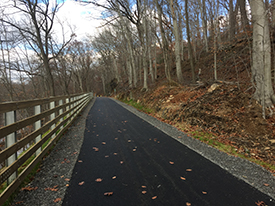Planner’s Portfolio: Community Trails
The 9th issue in the Planner’s Portfolio series focuses on design options for community trails.
Pedestrian paths and multi-use trails have become increasingly popular for satisfying transportation and recreational needs. They provide connections between communities and natural and historic resources, enhance recreational opportunities, and often conserve linear open spaces. In doing so, trails also provide a valuable recreational and fitness opportunity for all users.
Delaware County identified a Primary Trail Network as part of its Open Space, Recreation, and Greenway Plan (2015) to help create a cohesive trail system. It represents a countywide network of multi-use trails capable of connecting to both regional and municipal trail systems and destinations, such as parks and commercial centers. Municipalities should consider developing their trails in such a manner that they either construct segments of this network or design their internal trails to connect to Primary Trails.
 Multi-use trails are paved paths generally ten- to twelve-feet wide that can be used for non-motorized activities such as walking, running, bicycling, etc. Trailheads, which may include parking, are located at various points along the length of the trail to provide access. Multi-use trails serve as both recreational amenities and transportation corridors for the community. While they primarily serve the communities immediately surrounding the trail, they attract visitors and trail users from other communities as well.
Multi-use trails are paved paths generally ten- to twelve-feet wide that can be used for non-motorized activities such as walking, running, bicycling, etc. Trailheads, which may include parking, are located at various points along the length of the trail to provide access. Multi-use trails serve as both recreational amenities and transportation corridors for the community. While they primarily serve the communities immediately surrounding the trail, they attract visitors and trail users from other communities as well.
As multi-use trails are developed to provide connections, it is inevitable that they will cross roadways. Crossings should be designed to be extremely visible and provide adequate warnings to trail users as well as vehicles and pedestrians along the roadway. On many roadways, flashing signals can be activated by trail users to warn vehicles of cross-traffic on the trail. Painted crosswalks and other traffic-calming devices, such as medians, can help to slow down vehicular traffic and provide safer crossings.
Gates are installed across the trail to limit unauthorized vehicles while still providing space for trail users. The gates can be opened by first responders in the event of an emergency or for routine maintenance access.
Trails can take a variety of sizes and styles. This issue of the Planner’s Portfolio series focuses on the different styles of trails and bicycle connections and also discusses trail amenities.
For more information, check out the Community Trails issue or the entire Planner’s Portfolio series.
